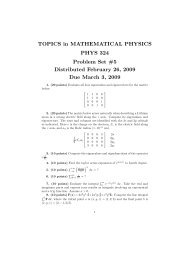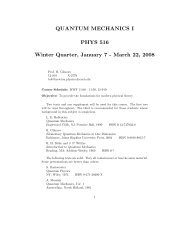Homework 7
Homework 7
Homework 7
- No tags were found...
Create successful ePaper yourself
Turn your PDF publications into a flip-book with our unique Google optimized e-Paper software.
<strong>Homework</strong> 7Problem 4. At 11:00AM on September 7, 2001, more than one million British school children jumped up and down for one minute. Thecurriculum focus of the “Giant Jump” was on earthquakes, but it was integrated with many other topics, such as exercise, geography,cooperation, testing hypothesis, ans setting world records. Children built their own seismographs that registered local effects. (a)Find the mechanical energy released in the experiment. Assume that N c = 1,050,000 children of an average mass m = 36.0 kg jumpN j = 12 times each, raising their centers of mass by h = 25.0 cm each time and briefly resting between one jump and the next. Thefree gall acceleration in Britain is g = 9.81 m/s 2 . (b) Most of the energy is converted very rapidly into internal energy within the bodiesof the children and the floors of the school buildings. Of the energy that propagates into the ground, most produces high frequency“microtremor” vibrations that are rapidly damped and cannot travel far. Assume that p = 0.01 % of the energy is carried away by along-range seismic wave. The magnitude of an earthquake on the Richter scale is given byM =logE − 4.81.5Where E is the seismic wave energy in joules. According to this model, what is the magnitude of the demonstration quake? It did notregister above background noise overseas or on the seismograph of the Wolverton Seismic Vault, Hampshire.(a) From “briefly resting between each jump” we are to conclude that each collision is perfectly inelastic (that all the mechanicalenergy the student had during the jump was lost into internal energies). The energy lost by one student preforming a single jump is justU g = mgh, so the energy lost during the entire experiment isE T = N c N j mgh = 1.05 · 10 6 · 12 · 36.0 kg · 9.81 m/s 2 · 0.250 m = 1.11 · 10 9 J (2)(b) The energy in long-range seismic waves is given by E = pE t /100 so the magnitude of the “quake” isM = log(0.01 · 1.11 · 109 ) − 4.81.5(1)= 0.164 (3)Problem 47. The system shown in Fig. P7.47 consists of a light inextensible cord, light frictionless pulleys, and blocks of equal mass. Itis initially held at rest so that the blocks are at the same height above the ground. The blocks are then released. Find the speed of blockA at the moment when the vertical separation of the blocks is h.Let m be the mass of one block, and îbe the vertical direction, with x = 0 for both blocks at their initial position. After someconsideration, we decide that block A will fall and block B will rise (if you are not convinced, find the mass that B must have in order forthe system to remain stationary). In order to get a quantitative relationship between the motion of the two blocks, imagine that B movesup a distance x in some time ∆t. Then block B will have an average velocity of v B = x/∆t, and block A will have gone a distance −2xwith an average velocity of v A = −2x/∆t. So x A = −2x B and v A = −2v B .When they are a distance h aparth = x B − x A = x B + 2x B = 3x B (4)So conserving energyx B = h 3x A = −2h3(5)(6)E i = K i +U gi = 0 = E f = K f +U g f = 1 2 mv2 A + 1 2 mv2 B + mg h 3 + mg−2h(7)3g 2h( ) 2 (3 = v2 A + v 2 B = v 2 −vAA + = v 2 A 1 + 1 )= 5 24 4 v2 A (8)√8ghv A =(9)15Problem 50. A child’s pogo stick (Fig/ P7.50) stores energy in a spring with a force constant of k = 2.50 · 10 4 N/m. At position A(x A = −0.100 m), the spring compression is a maximum and the child is momentarily at rest. At position B (x B = 0), the spring is relaxedand the child is moving upward. At position C, the child is again momentarily at rest at the top of the jump. The combined mass ofchild and pogo stick is m = 25.0 kg. (a) Calculate the total energy of the child-stick-Earth system, taking both gravitational and elasticpotential energy as zero for x = 0. (b) Determine x C . (c) Calculate the speed of the child at B. (d) Determine the value of x for which thekinetic energy of the system is a maximum. (e) Calculate the child’s maximum upward speed.1
And conserving energy between the top and bottomE B = 1 2 mv2 B = E T = 1 2 mv2 T + mg(2R) (28)v 2 B = v 2 T + 4gR = −gR + R N Bm = gR + RN T+ 4gRm(29)N B = N T + 6mg (30)3


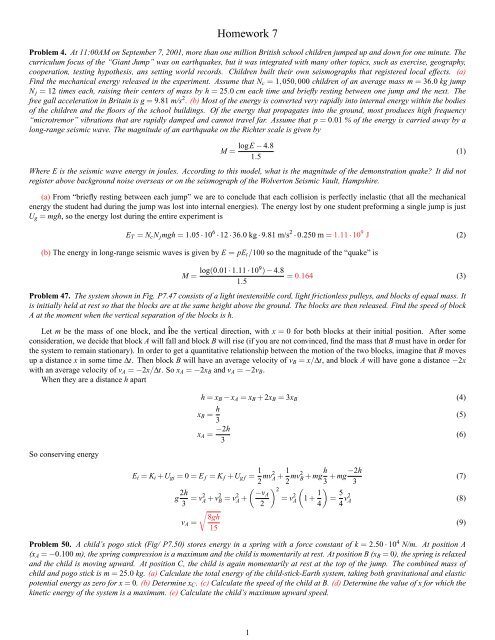
![[PDF] Problem Set #1](https://img.yumpu.com/51299607/1/190x245/pdf-problem-set-1.jpg?quality=85)
![[PDF] Problem Set #3](https://img.yumpu.com/50150452/1/184x260/pdf-problem-set-3.jpg?quality=85)
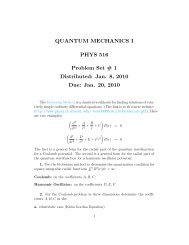
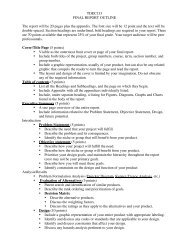
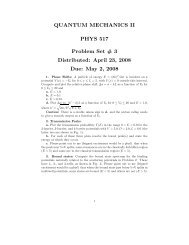
![[PDF] Problem Set #2](https://img.yumpu.com/45468456/1/184x260/pdf-problem-set-2.jpg?quality=85)
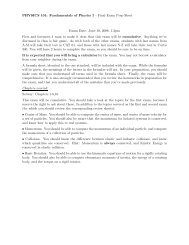
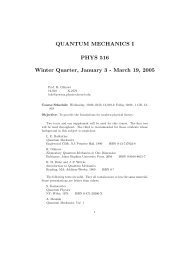
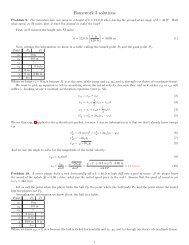
![[PDF] Xiang Liu: Fourier Transform Interferometer](https://img.yumpu.com/39562390/1/190x245/pdf-xiang-liu-fourier-transform-interferometer.jpg?quality=85)
![[PDF] Midterm Template](https://img.yumpu.com/39562028/1/184x260/pdf-midterm-template.jpg?quality=85)

